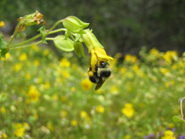Yellow monkey flower could shed light on a few of evolution's deepest mysteries

Researcher John Kelly's work involves the wildflower Mimulus guttatus (yellow monkeyflower).
More Information
LAWRENCE — The French impressionist Claude Monet once credited flowers as the reason for his "having become a painter."
Similarly, the University of Kansas' John Kelly might acknowledge a certain wildflower as guiding his career as a population genetics researcher.
The professor of ecology and evolutionary biology has spent years studying the yellow monkey flower (Mimulus guttatus) because the unassuming blossom offers insight into some of the most deep-seated questions about the tree of life.
"We work on the yellow monkey flower because it's a model," Kelly said. "Models are species that you study to learn about organisms in general."
Other common model organisms include fruit flies, nematodes and yeast, according to the researcher.
"It's not because people are fantastically interested in the particular features of a fruit fly or a yeast," said Kelly. "Instead, they study it because they can learn things about animal genetics in general much faster than by working on something they're more interested in — like humans. If we had to work only on humans to understand genetics, than it would have taken many additional decades to discover the chromosomal basis of inheritance, for example."
Kelly and his team grow thousands of the wildflowers in greenhouses at KU's Haworth Hall, allowing the researchers to follow genetic traits and changes over fast-reproducing generations, using techniques like controlled crosses, inbreeding and artificial selection, along with modern molecular approaches using DNA and next-generation genome sequencing. Their findings apply to a host of species beyond the greenhouse.
"It's pretty easy to relate the genome of yellow monkey flower to almost any other plant. For a core group of genes that have basic metabolic functions, we can find the same things in animals and fungi."
Kelly says his research with the flower explores basic questions such as, "Why is everyone different from everyone else?" He's interested in shedding light on whether variation in complex traits — such as the size of the yellow monkey flower — is part of the grand strategy of evolution or merely a byproduct of genetic mutation.
Since 2006, Kelly's research has been helped along by more than $3 million from the National Institutes of Health, in part because questions answered by his inquiry into the yellow monkey flower will apply to human biology. For instance, alleles (or alternative forms of a single gene) that control for size in yellow monkey flowers might clarify why there is variation in human height or disease susceptibility.
"For a trait like human height, there's a substantial amount of genetic variation out there," Kelly said. "But the simple truth is that we don't know why such variation exists. We don't know why, at all these genes that affect height, why you don't have just one single allele — whatever is optimal. We don't know why there are multiple different alleles out in the wild. We know that mutations produced them at some time in the past, but we don't know why they still exist today."
Further, an understanding of complex trait variation in a model species like the yellow monkey flower could lead to a better grasp of humans' genetic susceptibility to diseases like cancer and heart disease in humans.
"There are genuine and important differences between different groups of species," said Kelly. "But you'll learn more about human genetics working on something else. You'd learn about basic features — like the fact that genes reside on chromosomes — much more rapidly, by working on something that you can actually work on."